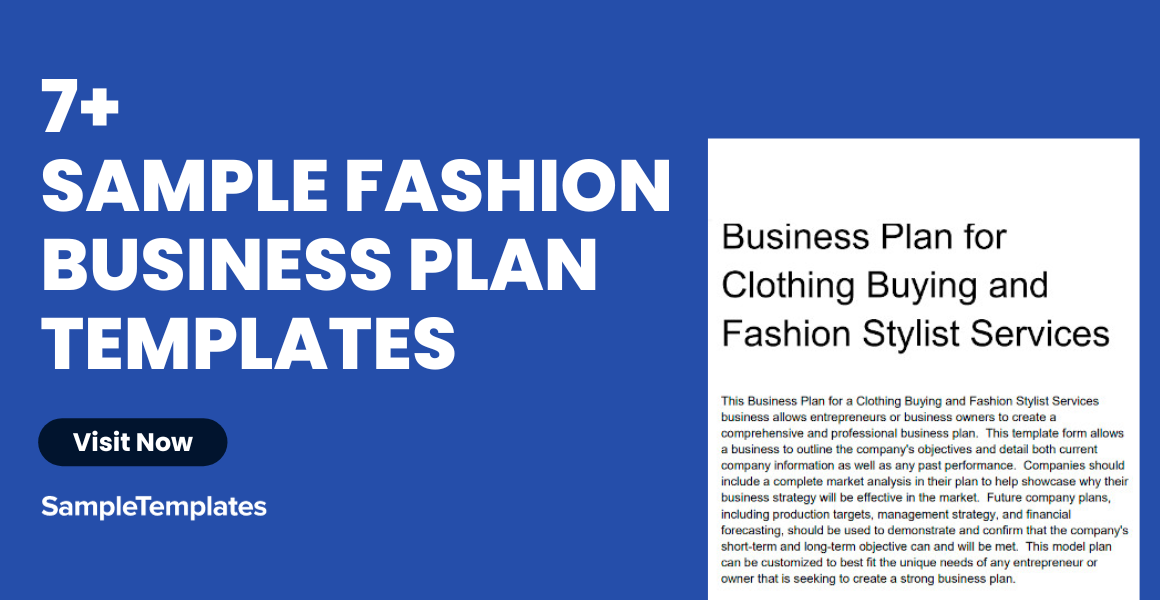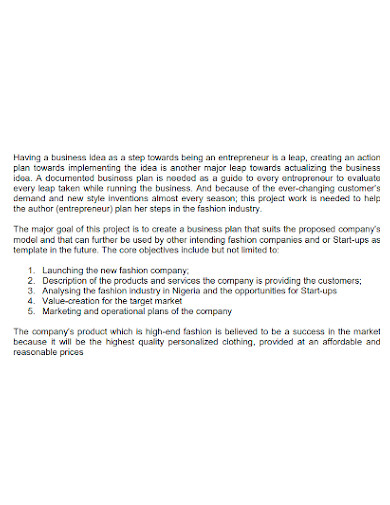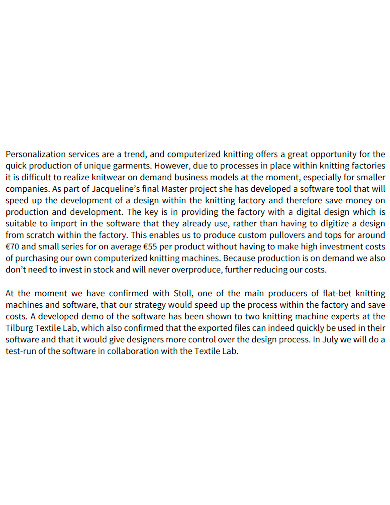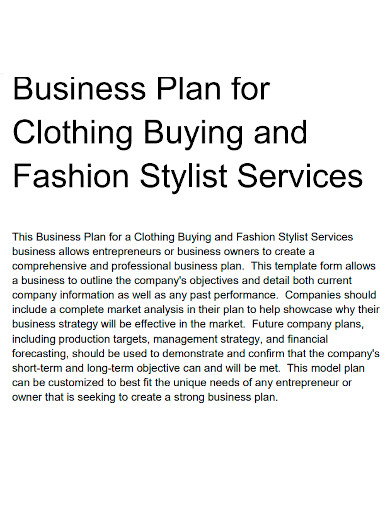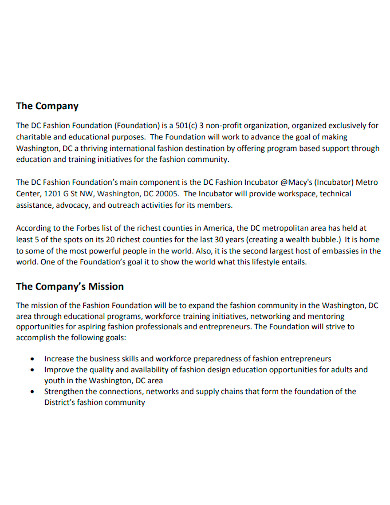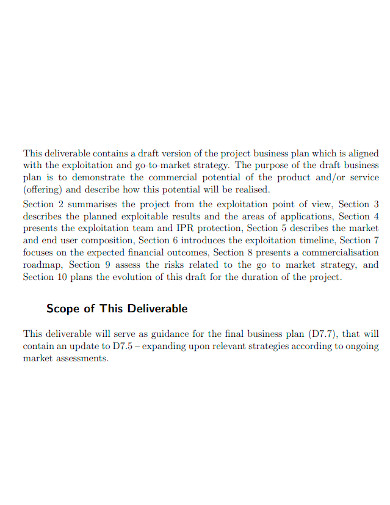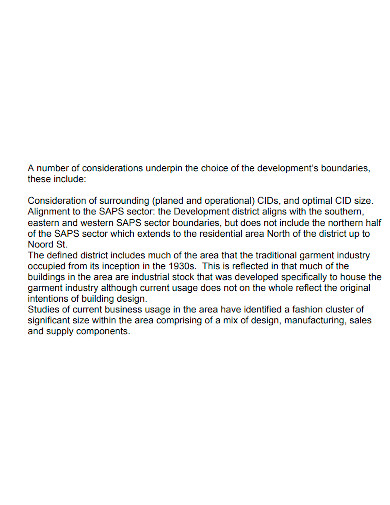For an aspiring fashion entrepreneur, it’s challenging to break out in the fashion industry without a strong grasp of the business. Fashion is more than just designing clothes and runway shows. There are researches within the market to be done, coming up with style ideas for a collection, collecting resources needed to create a garment, and so on. Nowadays, there is a big market in the fashion industry with millions of clothing stores all over the world. Since the fashion market is so vast, it can be intimidating for someone who is trying to make it. To be able to successfully break out in the fashion world, you should have a detailed, efficient fashion business plan.
7+ Fashion Business Plan Samples in PDF
1. Business Plan for Fashion Designer
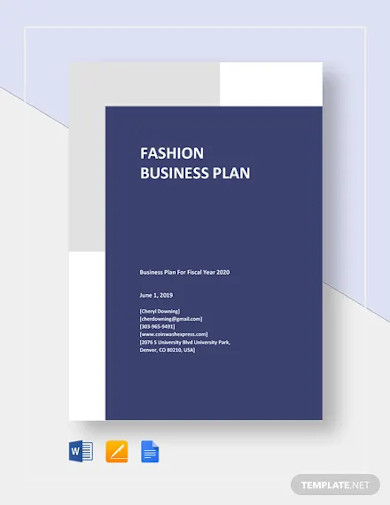
2. Sample Business Plan for Fashion Designer PDF
3. Fashion Business Proposal Sample PDF
How Do I Start a Fashion Business?
Starting a fashion business involves careful sample planning and execution. Here’s a step-by-step guide to help you launch your venture:
- Market Research: Understand your target market, identify competitors, and analyze trends. Determine the niche or unique selling proposition that will set your brand apart.
- Business Plan: Develop a comprehensive business plan outlining your brand, target audience, marketing strategy, financial projections, and operational plan. This plan will guide your decisions and attract potential investors.
- Legal Considerations: Register your business, choose a business structure (e.g., sole proprietorship, LLC), and address legal requirements. Protect your brand through trademark registration and ensure compliance with industry regulations.
- Brand Identity: Create a strong brand identity, including a memorable logo, brand colors, and a cohesive design aesthetic. Your brand should reflect the values and style that resonate with your target audience.
- Supplier and Production Partnerships: Establish relationships with reliable suppliers and manufacturers. Ensure transparent communication and quality control in the production process.
- Product Development: Design your products or curate a collection that aligns with your brand and appeals to your target market. Consider factors like pricing, materials, and manufacturing timelines.
- Online Presence: Build a professional website with e-commerce capabilities. Leverage social media platforms to showcase your products, engage with your audience, and drive traffic to your online store.
- Offline Presence: Explore opportunities for offline sales, such as pop-up shops, fashion events, or partnerships with retail stores. Networking and participating in local fashion shows can help increase brand visibility.
- Marketing and Promotion: Develop a comprehensive marketing strategy encompassing social media marketing, influencer collaborations, email campaigns, and content creation. Utilize both digital and traditional marketing channels to reach a broader audience.
- Sales and Distribution: Determine your sales channels, whether through your own online store, third-party platforms, or physical retail locations. Implement an effective inventory management system to meet customer demand.
- Customer Engagement: Foster a strong relationship with your customers through excellent customer service. Encourage feedback, respond to inquiries promptly, and consider implementing loyalty programs.
- Financial Management: Keep meticulous financial records, monitor expenses, and track sales. Develop a budget and regularly review your financial performance against your projections.
- Adapt and Evolve: Stay informed about industry trends and be willing to adapt your strategies. Continuously seek feedback from customers and use it to improve your products and services.
4. Sample of Business Plan for Fashion Designer PDF
5. Fashion and Design Business Plan PDF
How Do I Market My Small Fashion Business?
- Define Your Brand: Clearly articulate your brand identity, values, and unique selling proposition. Establish a compelling brand story that resonates with your target audience.
- Create an Online Presence: Develop a professional website with e-commerce capabilities. Leverage social media platforms like Instagram, Facebook, and Pinterest to showcase your products, engage with your audience, and drive traffic to your website.
- Social Media Marketing: Utilize visually appealing content, such as high-quality images and videos, to showcase your fashion products. Engage with your audience through comments, direct messages, and interactive posts. Collaborate with influencers to expand your reach.
- Content Marketing: Start a fashion blog or incorporate a blog section on your website. Create valuable content related to fashion trends, styling tips, and industry insights. This not only engages your audience but also improves your website’s SEO.
- Email Marketing: Build an email list and send regular newsletters to keep your audience informed about new arrivals, promotions, and exclusive offers. Personalize your emails to make them more appealing and relevant.
- Participate in Local Events: Attend local fashion events, markets, or pop-up shops to showcase your products. Networking at such events can help build relationships with customers and other businesses in the industry.
- Collaborate with Influencers: Partner with influencers or fashion bloggers who align with your brand. Their endorsement can introduce your products to a wider audience and build credibility.
- Offer Special Promotions: Run limited-time promotions, discounts, or exclusive offers to create a sense of urgency and drive sales. Consider loyalty programs to encourage repeat business.
- Optimize for Local SEO: Ensure your business appears in local search results by optimizing your website for local search engine optimization (SEO). This includes updating your Google My Business profile and obtaining positive customer reviews.
- Customer Engagement and Feedback: Encourage customer reviews and feedback. Engage with your customers on social media and respond promptly to inquiries. Positive customer experiences contribute to word-of-mouth marketing.
- Collaborate with Other Local Businesses: Partner with complementary local businesses for cross-promotions. This can expand your reach and introduce your brand to new audiences.
- Utilize Online Marketplaces: List your products on popular online marketplaces such as Etsy, Amazon, or eBay. This provides additional visibility and can attract customers searching for fashion products in those platforms.
6. Fashion Business Plan Example
7. Fashion Designer Business Plan
8. Fashion Design Business Plan Example PDF
How to Create A Fashion Business Plan
Do Some Research
Market research and competitive analysis are important to determine your target market, consumer problems, competitors. It also helps identify risks and avoid them in business decisions.
Other than research, consult a capitalist expert in the fashion industry for advice on writing a business plan. You can also visit clothing boutiques or online clothing stores to gather data on existing fashion trends and pricing structures and also receive advice from fashion designers.
Executive Summary
The executive summary or aptly nicknamed “elevator pitch” is a part of your fashion business plan that summarizes everything into two paragraphs or shorter. The summary should briefly mention your brand, target market, target revenue goals, and timeframe. It should also include your operations plans, and the type of clothing you will create.
Branding
Explain your branding style. Describe the clothing type and their marketability. Also, explain how your clothes will meet the needs and tastes of your target market. For example, you’re designing trendy professional clothes for working-class ladies age 25-45. The stylish yet comfortable clothes are versatile enough to wear to work, events, and dates. What differentiates these clothes from other fashion companies is they are made from sustainable fabrics.
Company Overview
Your company overview should include your background as a designer; your skills, past experiences, and education. Also include your business entity, store location, your organizational structure, your resources, and your business partners.
Manufacturing Plans
In this section, you must identify in great detail your suppliers and manufacturers who are producing your clothing line. Also, include your production costs.
Distribution Plans
After laying out your manufacturing plan, explain next your distribution plan. Hire distributors to help you get access to clothing retail stores (whether online or in department stores) or do a runway show where you can showcase your designs and secure orders from fashion retailers. Explain your working relationship with your distributors and your distribution costs.
Financial Plan
The last part of your fashion business plan is the financial plan. In this section, mention your expected revenues, expenses (especially your start-up costs), profits, and losses you might possibly encounter as your clothing business develops.
FAQs
What is a fashion business plan?
For every business entrepreneur, whether in the fashion industry or not, a business plan is important every start-up businessman as it details the structure of your business, your target customers, and revenue-generating ideas. For fashion designers, a fashion business plan illustrates not only the marketing part of your business but also your designs and clothing. This will develop your skills in combining creativity and business intelligence.
What are the four types of business plans?
The types of business plans are usually divided into four distinct parts: mini-plans or short plans, presentation plans, what-if plans or contingency plans, and working plans or operational plans.
How do you pitch a fashion business idea?
First, you need to be prepared mentally to do your business pitch. Your pitch should start with a good reason for starting your own fashion line. Next explain your product, your audience, your marketing strategies. Then explain your ways to generate revenue. Explain then your progress and your company’s vision in the coming years.
Is fashion business profitable?
The profitability of a fashion business depends on factors like brand positioning, market trends, effective marketing, and operational efficiency. Successful ventures with a unique appeal and strategic management can be highly profitable.
What are the seven types of fashion markets?
There are several types of fashion markets but they can be generally categorized into 7 market levels: haute couture, high street, fast fashion, luxury brands, economy, diffusion lines, and bridge brands.
Creating a fashion marketing plan is not an easy task that can be done in a week or so. The whole process takes a long time before you figure out your business plan. From doing research, obtaining resources, designing clothes, and looking for investors, it can be a taxing job. It’s important to seek out help and support from your family, friends, and mentor to guide you along the way. As long as you’re passionate enough about your business, then nothing can stop you from developing your fashion empire.
Related Posts
FREE 10+ Juice Bar Business Plan Templates in PDF MS Word
FREE 10+ Rental Property Business Plan Templates in PDF MS ...
FREE 7+ Sample Short Business Plan Templates in PDF MS Word
FREE 13+ Interior Design Business Plan Templates in PDF MS Word
FREE 14+ One-Page Business Plan Samples in MS Word Pages ...
FREE 13+ Sample Software Business Plan Templates in MS Word ...
FREE 10+ Sample Bar Business Plan Templates in MS Word PDF
FREE 11+ Sample Film Business Plan Templates in MS Word PDF
FREE 13+ Sample Daycare Business Plan Templates in MS Word ...
FREE 13+ Sample Nonprofit Business Plan in Google Docs MS ...
FREE 9+ Sample Service Business Plan Templates in PDF MS Word
FREE 6+ Sample Business Development Plan Templates in PDF
FREE 9+ Business Plan Profit and Loss Templates in PDF Excel
FREE 10+ Sample Strategic Business Plan Templates in Google ...
FREE 31+ Sample Business Plan Templates in Google Docs MS ...
